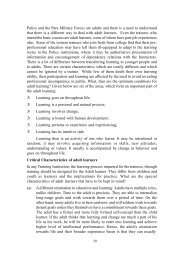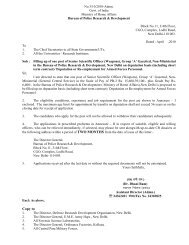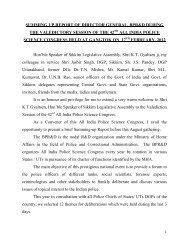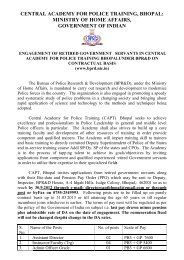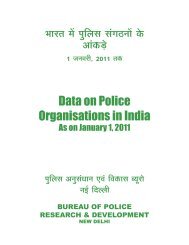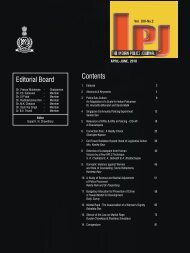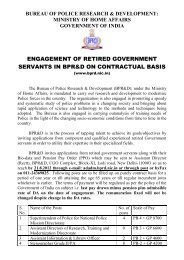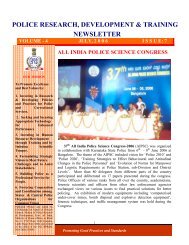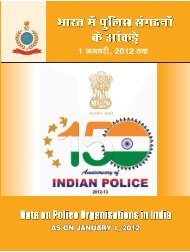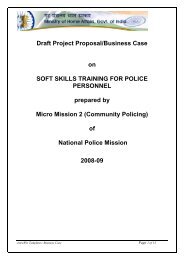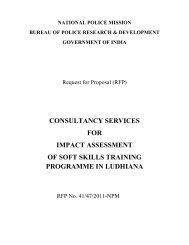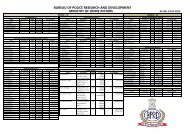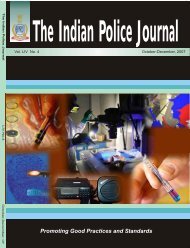the country to win the war that is already over.Reforms exclusively based on experience <strong>of</strong> thepast suffer from another infirmity. They fail t<strong>of</strong>actor in the innovations <strong>and</strong> transformations thatthe adversaries keep on bringing about in theircapacities, resources, strategies, collaborativenetworks, technology, equipments, targets, modusoper<strong>and</strong>i etc. As former US Secretary <strong>of</strong> Defence,Donald Rumsfeld, reflecting on the 21st centurythreats, observed that changes will have to be fast<strong>and</strong> constant to “defend against the unknown,the uncertain, the unseen <strong>and</strong> the unexpected”.These sets <strong>of</strong> changes, though more valid inoperational areas <strong>of</strong> intelligence generation liketrade craft, surveillance, penetration, technologyimprovisation etc. also have relevance in tools <strong>of</strong>analysis.Indian intelligence in the next ten years shouldpress into action an integrated strategy for change,incorporating a judicious mix <strong>of</strong> all the three sets<strong>of</strong> changes namely, evolutionary, reformist <strong>and</strong>transformational. In working out this strategyfor change, in addition to its long conventionalexperience, it may be necessary to factor in somenew emerging realities. Following are few suchfactors that may impact intelligence work in theyears ahead.Indian Intelligence, in times ahead, will haveto operate under greater public gaze, mediascrutiny <strong>and</strong> accountability regimen. It willhave to develop capability to operate in atranslucent, if not transparent environment.One <strong>of</strong> the conventional strengths <strong>of</strong> theintelligence organizations have been their abilityto operate in a relatively opaque <strong>and</strong> insulatedenvironment. It was an accepted norm that in thelarger security interests <strong>of</strong> the state <strong>and</strong> safety <strong>of</strong>its people, intelligence agencies be allowed tooperate outside the public gaze. Even outsidethe government, there was a tacit acceptance <strong>of</strong>this reality <strong>and</strong> the media, courts, scholars <strong>and</strong>analysts etc. implicitly respected this privilege<strong>and</strong> were careful not to draw them into publiccontroversies or expose their activities that mightundermine national or public interest. Criticismwas mostly confined to intelligence productionwhen it was felt that intelligence agencies hadfailed to alert or forewarn the governments. Exceptthe interested political groups who occasionallylevelled charges on the use <strong>of</strong> intelligence forpolitical purposes, the intelligence processes,by <strong>and</strong> large, remained under a veil <strong>of</strong> secrecy.This provided the requisite deniability to theintelligence pr<strong>of</strong>essionals, even when they had nolegal cover to carry out their secretive functions.The voluntary restraint exercised, was not somuch to protect the intelligence agencies or thegovernments, but more to deny undue advantageto the enemies <strong>of</strong> the state, who stood to gainby such exposures. Today, one <strong>of</strong> the mainsources <strong>of</strong> intelligence for the terrorists, spies <strong>and</strong>saboteurs are media reports. They learn aboutthe thinking <strong>and</strong> policies <strong>of</strong> the Government,movements <strong>and</strong> plans <strong>of</strong> the security agencies,details about arrests <strong>of</strong> their gang members <strong>and</strong>disclosures made by them, the people <strong>and</strong> placeson the radar <strong>of</strong> intelligence agencies etc. throughopen sources. In addition, media provides wide<strong>and</strong> prominent coverage to violent groups <strong>and</strong>their depredations, which enables them to getwide publicity <strong>and</strong> achieve the objective <strong>of</strong>terrorizing the people. It also enables them todiscredit <strong>and</strong> demoralize the governments inpower - the political objective <strong>of</strong> perpetratingterrorist actions. The live coverage <strong>of</strong> Mumbai26/11 terrorist attack, that was being monitoredby mentors <strong>of</strong> the terrorist group in Karachi, <strong>and</strong>who in turn were directing tactical movements <strong>of</strong>the terrorists, is a case in point.In times ahead, this problem is going to get furtherdeepened <strong>and</strong> accentuated. S<strong>of</strong>t states with opendemocracies, like India, will find themselvesparticularly vulnerable. For political reasons, legalrestraints or advisories to the media will neitherbe enforceable nor advisable. Frequency <strong>and</strong>intensity <strong>of</strong> front organizations, supporting thecause <strong>of</strong> anti-national forces, <strong>and</strong> masqueradingas human right groups, to put pressure on theintelligence <strong>and</strong> security agencies will show amarked increase. Even, dem<strong>and</strong>s for inclusion<strong>of</strong> intelligence agencies, or at least part <strong>of</strong> theiractivities, covered under the Right to InformationAct, may find political support.Unlike in the past when it was not a tabooedsubject, intelligence has entered the arena <strong>of</strong> publicdiscourse. We have to accept the reality as it is <strong>and</strong>not as we wish it to be. Not only the intelligenceproduction -- which can be a legitimate matter <strong>of</strong>public concern -- but even the processes, structures34The Indian <strong>Police</strong> Journal, October - December, 2012, Special Issue
<strong>and</strong> systems will increasingly come under publicscrutiny. Dem<strong>and</strong>s for parliamentary oversight,intervention in internal administrative matters,resistance to legal empowerment, like in the case<strong>of</strong> National Counter Terrorism Centre (NCTC),etc. are indicative <strong>of</strong> the changing environment.It will be desirable for the Indian intelligenceagencies to start revisiting their systems <strong>and</strong>making preparations for change, compatible withthe future realities, without undermining vitalnational interest.The Intelligence agencies should startdeliberating on a public interface mechanismwhich, in the long run, may even include amedia <strong>and</strong> public relations exercise. The wayIndian democracy is evolving, it will be in thenational interest to educate the media <strong>and</strong> haveworking relation with it, rather than allow it togo haywire for want <strong>of</strong> knowledge <strong>and</strong> authenticinformation. A well thought out action plan, onthis count, may take two to three years before itis made operational.Secondly, it will be desirable to have a group <strong>of</strong>experienced <strong>of</strong>ficers examine the entire working<strong>of</strong> the lB <strong>and</strong> R&AW <strong>and</strong> re-visit its security needs,through VED-analysis. Through a calibratedstrategy, it can secure vital secrets that may impingeon national security, while allowing controlledoversight by parliamentary or other bodies,where it will not hurt the vitals. Besides changesin tradecraft doctrines <strong>and</strong> practices, the changeswill involve, a whole new regimen <strong>of</strong> securityre-classification, changes in documentation <strong>and</strong>filing systems, communications, maintenance<strong>of</strong> records, weeding out <strong>of</strong> files etc. Intelligenceagencies should be able to bring about thischange in the next three to four years.Technology will have to be another focus areafor transformational change. This has twodistinct dimensions in intelligence. First isneutralizing efforts <strong>of</strong> the adversaries to acquire<strong>and</strong> operationalise technologies to undermineour national security. The second, pertainsto up-gradation <strong>and</strong> integration <strong>of</strong> state <strong>of</strong> arttechnologies by us to enhance our own defensive<strong>and</strong> <strong>of</strong>fensive capacities.The rate at which terrorists, spies, saboteurs<strong>and</strong> hostile intelligence agencies are acquiringnew technologies, poses a serious threat. Theseinclude a whole ambit <strong>of</strong> weapon systems,explosives, communication equipments, defeatsystems against conventional intelligencetradecraft etc. Recently, the use <strong>of</strong> social mediafor creating lawlessness <strong>and</strong> inciting people toviolence has underlined the scope <strong>of</strong> technologydriven threats. Incessant efforts being madeby the jehadi terrorists to acquire radioactiveexplosive devices (dirty bombs), is a matter<strong>of</strong> serious concern. With the conditions <strong>of</strong>instability in Af-Pak region getting accentuatedafter 2014 drawdown, ideologically motivatedIslamists taking charge <strong>of</strong> senior positions inPakistan Army <strong>and</strong> intelligence setups, deepeningcollaborative linkages <strong>of</strong> ISI with home grownradical groups like Indian Mujahedeen, in India,the intelligence challenges will get compoundedmanifold. Terrorist groups are also fast acquiringcapabilities <strong>of</strong> safe communication which willrender the task <strong>of</strong> interception quite difficult.In the area <strong>of</strong> defence, fast technological upgradationthrough heavy investments beingmade by hostile intelligence agencies like ISI <strong>of</strong>Pakistan, MSS <strong>of</strong> China etc. in electronic warfare,<strong>of</strong>fensive cyber capabilities, space surveillance,maritime encirclement <strong>of</strong> India etc. will have to befactored in for developing counter capabilities.Another aspect <strong>of</strong> technology in intelligencework relates to acquisition, improvisation <strong>and</strong>integration <strong>of</strong> new technologies. Though itsnecessity is disputed by none, the intricacies areunderstood by few. India’s strategic partnershipwith the US <strong>and</strong> greater security cooperationwith the West notwithst<strong>and</strong>ing, no developedcountry will share real state <strong>of</strong> the art intelligencetechnologies with India, particularly as a totalsystem. Even where the second rung technologiesare made available, they are fraught with danger,as the suppliers will insist on not transferring thecodes or allowing us to change them withouttheir involvement. Secrecy <strong>of</strong> our systems in thisdispensation is seriously undermined. India willdo well to take advantage <strong>of</strong> the <strong>of</strong>fset clause inacquisition <strong>of</strong> defence equipment <strong>and</strong> use part<strong>of</strong> it for indigenous production <strong>of</strong> intelligenceequipment. With India purchasing over $100billion worth <strong>of</strong> defence equipments in thenext seven to eight years, 30% <strong>of</strong> it under the<strong>of</strong>fset clause, provides us a huge investmentopportunity for this. Development <strong>of</strong> internal<strong>Research</strong> <strong>and</strong> Development capabilities areThe Indian <strong>Police</strong> Journal, October - December, 2012, Special Issue 35
- Page 1 and 2: The Indian Police JournalOctober -
- Page 3 and 4: From the Director’s DeskNew Delhi
- Page 5 and 6: 23rd December, 1887: TheJourney beg
- Page 7 and 8: Courtesy - National Archives of Ind
- Page 9 and 10: The Logo released on the completion
- Page 11 and 12: Helmsmen of the IB during thePre-In
- Page 13 and 14: SHRI V.G. VAIDYA, IPS(MAR 1992 TO J
- Page 15 and 16: “Sleeman sahib ki jai”“No Cri
- Page 17 and 18: their life and their problems relat
- Page 19 and 20: Settling down of criminal tribes wa
- Page 21 and 22: perish. Between 1841 and 1848, anot
- Page 23 and 24: In conclusion, I would like to reco
- Page 25 and 26: own race alone, had to be withdrawn
- Page 27 and 28: a bee in his bonnet” 17 , and abo
- Page 29 and 30: epresented by Tilak and his followe
- Page 31 and 32: The agency more and more fine-tuned
- Page 33 and 34: US was brewing, one William Hopkins
- Page 35 and 36: came under the control of Indian mi
- Page 37 and 38: neutralised many efforts by inimica
- Page 39 and 40: e published by the Intelligence Bur
- Page 41 and 42: As DD (Security), IB, I had occasio
- Page 43 and 44: Chhomohlohri, all of them juxtapose
- Page 45 and 46: Dormers Building, ShimlaThe Dormers
- Page 47: eforms. Warren Commission, on the a
- Page 51 and 52: violence and destabilisation. This
- Page 53 and 54: one develop. The all pervasive cult
- Page 55 and 56: etween the states and the centre su
- Page 57 and 58: Intelligence Agencies inIndian Demo
- Page 59 and 60: Democracies are, today, everywhere
- Page 61 and 62: depend substantially on the restrai
- Page 63 and 64: Of Pistols and Pigs andthe Old Tidd
- Page 65 and 66: it is lovingly caressed hundreds of
- Page 67 and 68: Through the Eyes of an IB OfficerSh
- Page 69 and 70: an Intelligence agency. He used to
- Page 71 and 72: My J&K ExperienceShri R.K. Kapoor,
- Page 73 and 74: there. We remained stranded there f
- Page 75 and 76: Scaling Himalayan Heights withthe I
- Page 77 and 78: proceed to Dungti to supervise the
- Page 79 and 80: tour of the White House and Lincoln
- Page 81 and 82: into unconsciousness two hours earl
- Page 83 and 84: which was completed successfully wi
- Page 85 and 86: leaders. This happened around the t
- Page 87 and 88: My Unforgettable Yearsin the North-
- Page 89 and 90: stated that Prakash Singh, Assistan
- Page 91 and 92: take her into confidence. That woul
- Page 93 and 94: Police - Intelligence InterfaceShri
- Page 95 and 96: Shreekant Bapat and I surveyed the
- Page 97 and 98: excellence, dedication and commitme
- Page 99 and 100:
Immigration, Inter-State Disputes,
- Page 101 and 102:
Observations on India’s State and
- Page 103 and 104:
assessments that arose after the ca
- Page 105 and 106:
levels. The deficiencies of one par
- Page 107 and 108:
of laying a network of useful roads
- Page 109 and 110:
Technology in Intelligence-Future S
- Page 111 and 112:
These are just some of the aspects
- Page 113 and 114:
Figure 6: Open Source Information o
- Page 115 and 116:
events) and inference from evidence
- Page 117 and 118:
9North Atlantic Treaty Organization
- Page 119 and 120:
Shri Dave was posted back to the lB
- Page 121 and 122:
He even suggested separate pay scal
- Page 123 and 124:
The Unsung HeroesThe Intelligence B



